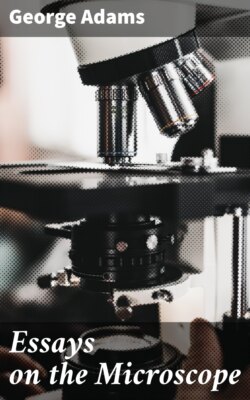Читать книгу Essays on the Microscope - George Comp Adams - Страница 29
На сайте Литреса книга снята с продажи.
A LIST OF THE APPARATUS TO CUFF’S DOUBLE-CONSTRUCTED MICROSCOPE.[33]
Оглавление[33] This microscope is made oftentimes with a joint at the bottom of the main pillar at e, to admit placing the instrument into any oblique situation, and connected to the bottom of a mahogany chest; on which account, it is by some of the instrument makers called the Chest Compound Microscope. Edit.
H, a convex lens, to collect the rays of light from the sun or a candle, and condense them on the object, or to magnify a flower or other large object placed upon the stage.
L, a cylindrical tube, open at each side, with a concave silver speculum screwed to the lower end h.
P, the slider-holder; it consists of a cylindrical tube, in which an inner tube is forced upwards by a spiral spring, it is used to receive an ivory slider K, which is to be slid between the plates h and i. The cylinder P fits the hole n in the stage: the hollow part at k is designed to receive a glass tube N.
R is a brass cone, to be put under the bottom of the cylinder P, to intercept occasionally some of the rays of light.
S, a box containing a concave and a flat glass, between which a small living insect may be confined; it is to be placed over the hole n.
T, a flat glass to lay any occasional object upon; there is also a concave one u, for fluids.
O, a long steel wire, with a small pair of pliers at one end, and a point at the other, designed to stick or hold objects; it slips backwards and forwards in the short tube o; the pin p fits into an hole m, in the stage for that purpose.
W, a little round ivory box, to hold a supply of talc and rings for the sliders.
Z, a hair brush, to wipe any dust off the glasses, or to take up by the other end a drop of any liquid.
V, a small ivory cylinder, that fits on the pointed end of the steel wire O; it is designed for opake objects. Light-coloured ones are to be stuck upon the dark side, and vice versa.
Y, a common magnifying glass for any occasional purpose.
M, a fish-pan whereon to fasten a small fish, to view the circulation of the blood: the tail is to be spread across the oblong hole at the small end k, and tied fast by means of a ribband fixed thereto; the knob l is to be put through the slit made in the stage, and the tail may be brought under the magnifier.
X is a wire to clean the glass tubes by.
